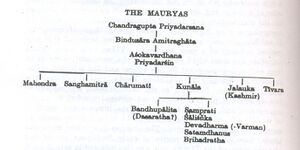Dasarath Maurya
For Raja Dasharatha of Ramayana (father of Lord Rama), please see → King Dasharatha
Dasarath Maurya (232BC-224BC) was the successor of Ashoka the Great and ruled over the Mauryan Empire from 232 B.C. to 224 B.C.
List of Maurya Kings

- 320–298 BCE: Chandragupta
- 298–272 BCE: Bindusara
- 268–232 BCE: Ashoka
- 232–224 BCE: Dasharatha
- 224–215 BCE: Samprati
- 215–202 BCE: Shalishuka
- 202–195 BCE: Devavarman
- 195–187 BCE: Shatadhanvan
- 187–185 BCE: Brihadratha
History
Dasaratha uses Asoka’s title Devanampiya in the inscriptions incised on the walls of the rock-cut caves which he bestowed upon the Ajivikas on the heights of Nagarjuni hills. [1]
Inscription of Dasaratha Maurya on the cave of Gopika
Gopika cave: Also called Gopi or Gopi-ka-Kubha or simply Nagarjuni, Gopika cave is the largest of all the caves of the Barabar complex (25.009116°N 85.078427°E). It consists of a single large oblong room of 13.95x5.84m. The two ends of the room have the particularity of being circular, contrary to the other caves. The cave lies on the south bank of the hill, dug by King Dasharatha Maurya ,grandson of Emperor Ashoka, according to the inscription that was engraved above the front door:
The cave of Gopika, a refuge that will last as long as the sun and the moon, was dug by Devanampiya (beloved of the gods) Dasaratha during his elevation to the throne, to make a hermitage for the most pious Ajivikas.... — Inscription of Dasaratha Maurya on the cave of Gopika. About 230 BCE.[2]
Ghanghani Inscription of Samprati Maurya
Ghanghani (घंघाणी) is a village in tahsil Bhopalgarh of Jodhpur district in Rajasthan.
Ghanghani is situated near Asarnada (आसरनाडा) railway station on Bikaner-Jodhpur line. There is an ancient Jaina Temple. According to Jaina poet Samayasundara the ancient sculptures bear Inscription of Samprati Maurya, Dasarath Maurya's son and granson of Ashoka Maurya. This indicates that he built a grand Padmaprabhu Jinalaya temple.[3]
External links
Further reading
- http://en.wikipedia.org/wiki/Mauryan
- Ram Swarup Joon: History of the Jats, Rohtak, India (1938, 1967)
- Dr Natthan Singh: Jat - Itihas (Hindi), Jat Samaj Kalyan Parishad Gwalior, 2004
References
- ↑ (ed.) R.C. Majumdar, The Age of Imperial Unity, (Bombay, 1960), p.89
- ↑ Buddhist Architecture par Huu Phuoc Le p.102
- ↑ Aitihasik Sthanavali by Vijayendra Kumar Mathur, p.311
Back to The Rulers

